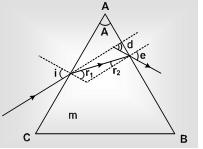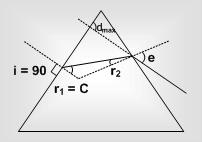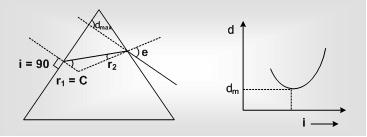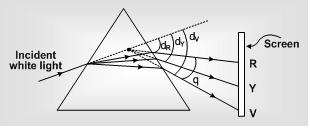Prism Optics
Prism is a transparent medium bounded by refracting surfaces, such that the incident surface (on which light ray is incidenting) and emergent surface (from which light rays emerges) are plane and non parallel.
Prism Refraction

i → Angle of incidence,
e → Angle of emergence,
A → Angle of prism or refracting angle of prism,
r1 and r2 → Angle of refraction,
δ → Angle of deviation
A = r1 + r2 and i + e = A + δ
For surface AC µ = sin i/sin r1; For surface AB 1/µ = sin r2/sin e
Prism Deviation:
For thin prism δ = (µ –1)A. Also deviation is different for different colour light e.g. µR < µV so δR < δV.
µFlint > µCrown so δr > δc
(i) Maximum deviation: Condition of maximum deviation is
i = 90o => r1 = C, r2 = A – C

and from Snell's law on emergent surface
e = sin–1 [sin(A–C)/sin C]
δmax = π/2 + sin–1 [sin(A–C)/sin C] – A
(ii) Minimum deviation: It is observed if i = e and r1 = r2 = r, deviation produced is minimum.

(a) Refracted ray inside the prism is parallel to the base of the prism for equilateral and isosceles prisms.
(b) r = A/2 and i = A + δm/2
(c)  (Prism formula)
(Prism formula)
 (Prism formula)
(Prism formula)
Prism Dispersion
The splitting of white light into its constituent colors is called dispersion of light.
Angular dispersion (θ): Angular separation between extreme colours i.e. θ = δV – δR = (µV – µR)A. It depends upon µ and A.

Dispersive power (ω): ω = θ/δy = µV –µR/µy – 1
where {µy – µV+µR/2}
=> It depends only upon the material of the prism i.e. m and it doesn't depends upon angle of prism A
